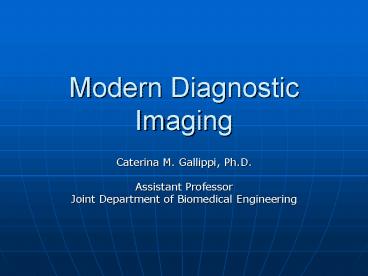Modern Diagnostic Imaging PowerPoint PPT Presentation
1 / 40
Title: Modern Diagnostic Imaging
1
Modern Diagnostic Imaging
- Caterina M. Gallippi, Ph.D.
- Assistant Professor
- Joint Department of Biomedical Engineering
2
Why Medical Imaging?
3
History of Medical Imaging X-Ray
- 1895 first X-ray, Roentgen
- Static
- Dynamic
- Planar
- 1972 - tomographic X-ray, Hounsfield and Cormack
- Nobel Prize in Medicine, 1979
4
History of Medical Imaging Nuclear
- 1896 discovery of radioactivity, Becquerrel
- 1923 radioactive tracers, de Hevesy
- 1937 technetium-99m, Segre and Segre
- 1952 Anger scintillation camera, Anger
5
History of Medical Imaging Ultrasound
- 1900 interaction of acoustic waves with media,
Lord Rayleigh - WWII Navy Sonar
- 1960s A-mode and B-mode scans
- 1970s Doppler, phased array
6
History of Medical Imaging MRI
- 1950s nuclear magnetic resonance, Block and
Purcell - 1952 Nobel Prize in Physics
- 1973 application to medicine, Lauterbur
- 2003 Nobel Prize in Medicine, Lauterbut and
Mansfield
7
Ionizing v Non-ionizing
- Ionizing radiation electromagnetic radiation
whose waves contain energy sufficient to overcome
the binding energy of electrons in atoms or
molecules, thus creating ions. - X-ray
- CT
- Nuclear Imaging
8
X-ray
- X-rays transmitted into body by x-ray tube in a
3-D cone shape - Tissue selectively attenuates x-ray intensity
- X-ray energy converted to visible light by
scintillator - Image captured by photographic film
- Projection Radiography - projection of 3D
object onto a 2D image
9
X-ray Systems
Detector
Emitter
Thoracic
Peripheral
10
X-ray Images
11
X-ray Images
12
Question 1
- Why does bone appear white on the X-ray images?
13
Computed Tomography
- Uses x-rays
- Instead of a cone shape, x-rays are collimated
- Large number of small detectors
- Measurements collected for many angular
orientations - Image of cross section computed from projections
- Tomographic Image a 2D slice
14
CT System
15
CT Image
16
Question 2
- How can CT be used to generate 3D images?
17
CT Images
18
(No Transcript)
19
(No Transcript)
20
(No Transcript)
21
How Much is Too Much?
22
Nuclear Imaging
- Images can only be made after injection,
ingestion, or inhalation of radioactive
substances. - Radioactive material decays, emitting gamma rays
or positrons - Biological carrier to demonstrate biological
function - Substances emit gamma rays
- Image reflects local concentration of radiotracer
23
Conventional Nuclear Imaging
- Scintigraphy
- Gamma ray detector Anger camera
- Detects single rays, rather than a collective
beam - Combines emission with attenuation
- Images 2D projections of 3D distribution of
radiotracers
24
SPECT
- Single-Photon Emission Computed Tomography
- Anger camera rotates
- Computed tomographic methods to reconstruct 2D
slice - 3D imaging
25
SPECT System
26
Fused SPECT/CT
27
PET
- Radionuclide decay produces a positron
- Positron electron 2 gamma rays flying in
opposite directions - PET scanner identifies coincident detections from
opposite directions. - A line of imaging is determined
28
PET System
29
Pet Images
30
Pet Images
31
MRI
- Nuclear magnetic resonance in a strong magnetic
field, the nucleus of a hydrogen atom (a proton)
tends to align itself with the field.
32
MRI
- Results in net magnetization of the body
- Can then selectively excite regions within the
body to align differently - As (charged) protons return to alignment, an RF
signal is generated - Image created using FT
33
Question 3
- Why is the Fourier Transform relevant to image
creation in MRI?
34
MRI System
35
(No Transcript)
36
(No Transcript)
37
(No Transcript)
38
Bonus Questions
- Which imaging modality is strictly functional?
- How could you make MRI functional?
- What limitations inhibit clinical applicability?
39
Whats Missing?
40
cmgallip_at_bme.unc.edu

